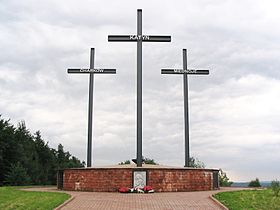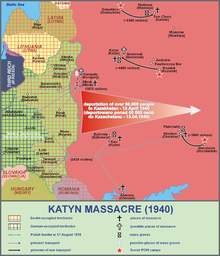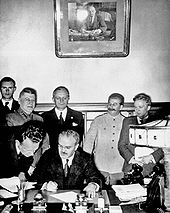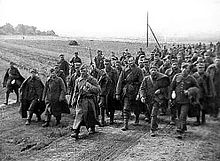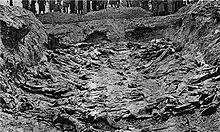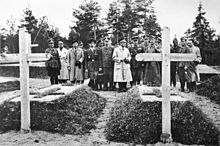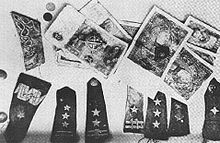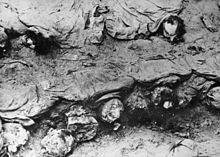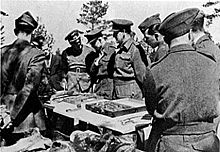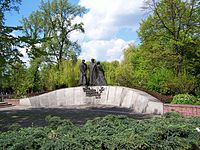
Katyn massacre
Did you know...
This selection is made for schools by a children's charity read more. A quick link for child sponsorship is http://www.sponsor-a-child.org.uk/
The Katyn massacre, also known as the Katyn Forest massacre ( Polish: zbrodnia katyńska, mord katyński, 'Katyń crime'; Russian: Катынский расстрел Katynskij ra'sstrel 'Katyn shooting'), was a mass execution of Polish nationals carried out by the People's Commissariat for Internal Affairs ( NKVD), the Soviet secret police, in April and May 1940. The massacre was prompted by Lavrentiy Beria's proposal to execute all members of the Polish Officer Corps, dated 5 March 1940. This official document was approved and signed by the Soviet Politburo, including its leader, Joseph Stalin. The number of victims is estimated at about 22,000, with 21,768 being a lower bound. The victims were murdered in the Katyn Forest in Russia, the Kalinin and Kharkiv prisons and elsewhere. Of the total killed, about 8,000 were officers taken prisoner during the 1939 Soviet invasion of Poland, another 6,000 were police officers, with the rest being Polish intelligentsia arrested for allegedly being " intelligence agents, gendarmes, landowners, saboteurs, factory owners, lawyers, officials and priests."
The term "Katyn massacre" originally referred specifically to the massacre at Katyn Forest, near the villages of Katyn and Gnezdovo (approximately 19 kilometers/12 miles west of Smolensk, Russia), of Polish military officers in the Kozelsk prisoner-of-war camp. This was the largest of several simultaneous executions of prisoners of war. Other executions occurred at the geographically distant Starobelsk and Ostashkov camps, at the NKVD headquarters in Smolensk, and at prisons in Kalinin (Tver), Kharkiv, Moscow, and other Soviet cities. Still more executions took place at various locations in Belarus and Western Ukraine, based on special lists of Polish prisoners, prepared by the NKVD specifically for those regions. The modern Polish investigation of the killings covered not only the massacre at Katyn forest, but also the other mass murders mentioned above. Polish organisations, such as the Katyn Committee and the Federation of Katyn Families, consider the victims murdered at the locations other than Katyn as part of the overall massacre.
The government of Nazi Germany announced the discovery of mass graves in the Katyn Forest in 1943. When the London-based Polish government-in-exile asked for an investigation by the International Red Cross, Stalin immediately severed diplomatic relations with it. The Soviet Union claimed the victims had been murdered by the Nazis, and continued to deny responsibility for the massacres until 1990, when it officially acknowledged and condemned the perpetration of the killings by the NKVD, as well as the subsequent cover-up.
An investigation conducted by the Prosecutor General's Office of the Soviet Union (1990–1991) and the Russian Federation (1991–2004), has confirmed Soviet responsibility for the massacres. It was able to confirm the deaths of 1,803 Polish citizens but refused to classify this action as a war crime or an act of genocide. The investigation was closed on grounds that the perpetrators of the massacre were already dead, and since the Russian government would not classify the dead as victims of Stalinist repression, formal posthumous rehabilitation was ruled out. The human rights society Memorial issued a statement which declared "this termination of investigation is inadmissible" and that their confirmation of only 1,803 people killed "requires explanation because it is common knowledge that more than 14,500 prisoners were killed." In November 2010, the Russian State Duma approved a declaration blaming Stalin and other Soviet officials for having personally ordered the massacre.
Background
On 1 September 1939, Nazi Germany invaded Poland. Meanwhile, Britain and France, obligated by the Polish-British Common Defense Pact and Franco-Polish Military Alliance to attack Germany in the case of such an invasion, demanded that Germany withdraw. On 3 September 1939, after it failed to do so, France, Britain, and most countries of the British Commonwealth declared war on Germany but provided little military support to Poland. They took little other significant military action during what became known as the Phoney War.
The Soviet Union began its own invasion on 17 September, in accordance with the Molotov-Ribbentrop Pact. The Red Army advanced quickly and met little resistance, as Polish forces facing them were under orders not to engage the Soviets. About 250,000-454,700 Polish soldiers and policemen had become prisoners and were interned by the Soviet authorities. Some were freed or escaped quickly, while 125,000 were imprisoned in camps run by the NKVD. Out of those, 42,400 soldiers, mostly of Ukrainian and Belarusian ethnicity serving in the Polish army who lived in the former Polish territories now annexed by the Soviet Union, were released in October. The 43,000 soldiers born in West Poland, then under German control, were transferred to the Germans; in turn the Soviets received 13,575 Polish prisoners from the Germans.
In addition to military and government personnel, other Polish citizens suffered from repressions. Thousands of members of the Polish intelligentsia were also arrested and imprisoned for allegedly being "intelligence agents, gendarmes, landowners, saboteurs, factory owners, lawyers, officials and priests." Since Poland's conscription system required every nonexempt university graduate to become a military reserve officer, the NKVD was able to round up a significant portion of the Polish educated class. According to estimates by Institute of National Remembrance (IPN), roughly 320,000 Polish citizens were deported to the Soviet Union (this figure is questioned by some other historians, who stand by the older estimate of about 700,000–1,000,000). IPN estimates the number of Polish citizens that died under Soviet rule during World War II at 150,000 (a correction of the older estimates of up to 500,000). Of the one group of 12,000 Poles sent to Dalstroy camp (near Kolyma) in 1940–1941, most POWs, only 583 men survived, released in 1942 to join the Polish Armed Forces in the East. According to Tadeusz Piotrowski, "...during the war and after 1944, 570,387 Polish citizens had been subjected to some form of Soviet political repression."
As early as 19 September, Lavrentiy Beria ordered the NKVD to create the Administration for Affairs of Prisoners of War and Internees to manage Polish prisoners. The NKVD took custody of Polish prisoners from the Red Army, and proceeded to organise a network of reception centers and transit camps and arrange rail transport to prisoner-of-war camps in the western USSR. The largest camps were located at Kozelsk ( Optina Monastery), Ostashkov ( Stolbnyi Island on Seliger Lake near Ostashkov) and Starobelsk. Other camps were at Jukhnovo (rail station "Babynino"), Yuzhe (Talitsy), rail station "Tyotkino" 90 kilometres/56 miles from Putyvl), Kozelshchyna, Oranki, Vologda (rail station "Zaonikeevo") and Gryazovets.
Kozelsk and Starobelsk were used mainly for military officers, while Ostashkov was used mainly for Polish boy scouts, gendarmes, police and prison officers. Some prisoners were members of other groups of Polish intelligentsia, such as priests, landowners and law personnel. The approximate distribution of men throughout the camps was as follows: Kozelsk, 5,000; Ostashkov, 6,570; and Starobelsk, 4,000. They totaled 15,570 men.
According to a report from 19 November 1939, the NKVD had about 40,000 Polish POWs: about 8,000–8,500 officers and warrant officers, 6,000–6,500 police officers and 25,000 soldiers and NCOs who were still being held as POWs. In December, a wave of arrests took into custody some Polish officers who were not yet imprisoned, Ivan Serov reported to Lavrentiy Beria on 3 December that "in all, 1,057 former officers of the Polish Army had been arrested." The 25,000 soldiers and non-commissioned officers were assigned to forced labors (road construction, heavy metallurgy).
Once at the camps, from October 1939 to February 1940, the Poles were subjected to lengthy interrogations and constant political agitation by NKVD officers such as Vasily Zarubin. The prisoners assumed that they would be released soon, but the interviews were in effect a selection process to determine who would live and who would die. According to NKVD reports, if the prisoners could not be induced to adopt a pro-Soviet attitude, they were declared "hardened and uncompromising enemies of Soviet authority."
On 5 March 1940, pursuant to a note to Joseph Stalin from Beria, four members of the Soviet Politburo – Stalin, Vyacheslav Molotov, Kliment Voroshilov, and Anastas Mikoyan – signed an order to execute 25,700 Polish "nationalists and counterrevolutionaries" kept at camps and prisons in occupied western Ukraine and Belarus. The reason for the massacre, according to historian Gerhard Weinberg, was that Stalin wanted to deprive a potential future Polish military of a large portion of its talent:
"It has been suggested that the motive for this terrible step [the Katyn massacre] was to reassure the Germans as to the reality of Soviet anti-Polish policy. This explanation is completely unconvincing in view of the care with which the Soviet regime kept the massacre secret from the very German government it was supposed to impress.... A more likely explanation is that... [the massacre] should be seen as looking forward to a future in which there might again be a Poland on the Soviet Union's western border. Since he intended to keep the eastern portion of the country in any case, Stalin could be certain that any revived Poland would be unfriendly. Under those circumstances, depriving it of a large proportion of its military and technical elite would make it weaker."
In addition, Soviets realized that the prisoners constituted a large body of trained and motivated Poles who would not accept a Fourth Partition of Poland.
Executions
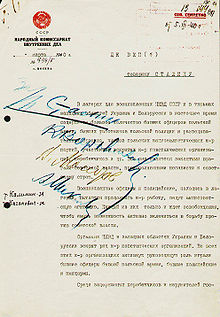
The number of victims is estimated at about 22,000, with a lower bound of confirmed dead of 21,768. According to Soviet documents declassified in 1990, 21,857 Polish internees and prisoners were executed after 3 April 1940: 14,552 prisoners of war (most or all of them from the three camps) and 7,305 prisoners in western parts of the Belarusian and Ukrainian SSRs. Of them 4,421 were from Kozelsk, 3,820 from Starobelsk, 6,311 from Ostashkov, and 7,305 from Belarusian and Ukrainian prisons. Head of the NKVD POW department, Maj. General P.K. Soprunenko, organized "selections" of Polish officers to be massacred at Katyn and elsewhere.
Those who died at Katyn included an admiral, two generals, 24 colonels, 79 lieutenant colonels, 258 majors, 654 captains, 17 naval captains, 3,420 NCOs, seven chaplains, three landowners, a prince, 43 officials, 85 privates, 131 refugees, 20 university professors, 300 physicians; several hundred lawyers, engineers, and teachers; and more than 100 writers and journalists as well as about 200 pilots. In all, the NKVD executed almost half the Polish officer corps. Altogether, during the massacre the NKVD murdered 14 Polish generals: Leon Billewicz (ret.), Bronisław Bohatyrewicz (ret.), Xawery Czernicki (admiral), Stanisław Haller (ret.), Aleksander Kowalewski (ret.), Henryk Minkiewicz (ret.), Kazimierz Orlik-Łukoski, Konstanty Plisowski (ret.), Rudolf Prich (murdered in Lviv), Franciszek Sikorski (ret.), Leonard Skierski (ret.), Piotr Skuratowicz, Mieczysław Smorawiński and Alojzy Wir-Konas (promoted posthumously). Not all of the executed were ethnic Poles, because the Second Polish Republic was a multiethnic state, and its officer corps included Belorussians, Ukrainians, and Jews. It is estimated that about 8% of Katyn massacre victims were Polish Jews. 395 prisoners were spared from the slaughter, among them Stanisław Swianiewicz and Józef Czapski. They were taken to the Yukhnov camp and then to Gryazovets.
Up to 99% of the remaining prisoners were subsequently murdered. People from the Kozelsk camp were murdered in the mass murder site of Smolensk countryside, in the Katyn forest; people from the Starobelsk camp were murdered in the inner NKVD prison of Kharkiv and the bodies were buried near Piatykhatky; and police officers from the Ostashkov camp were murdered in the inner NKVD prison of Kalinin ( Tver) and buried in Mednoye.
Detailed information on the executions in the Kalinin NKVD prison was given during a hearing by Dmitrii Tokarev, former head of the Board of the District NKVD in Kalinin. According to Tokarev, the shooting started in the evening and ended at dawn. The first transport on 4 April 1940, carried 390 people, and the executioners had a hard time killing so many people during one night. The following transports were no greater than 250 people. The executions were usually performed with German-made 7.65 mm Walther PPK pistols supplied by Moscow, but 7.62x38R Nagant M1895 revolvers were also used. The executioners used German weapons rather than the standard Soviet revolvers, as the latter were said to offer too much recoil, which made shooting painful after the first dozen executions. Vasili Mikhailovich Blokhin, chief executioner for the NKVD—and quite possibly the most prolific executioner in history—is reported to have personally shot and killed 7,000 of the condemned, some as young as 18, from the Ostashkov camp at Kalinin prison over a period of 28 days in April 1940.
The killings were methodical. After the personal information of the condemned was checked, he was handcuffed and led to a cell insulated with stacks of sandbags along the walls and a felt-lined, heavy door. The victim was told to kneel in the middle of the cell, was then approached from behind by the executioner and immediately shot in the back of the head. The body was carried out through the opposite door and laid in one of the five or six waiting trucks, whereupon the next condemned was taken inside. In addition to muffling by the rough insulation in the execution cell, the pistol gunshots were also masked by the operation of loud machines (perhaps fans) throughout the night. This procedure went on every night, except for the May Day holiday.
Some 3,000 to 4,000 Polish inmates of Ukrainian prisons and those from Belarus prisons were probably buried in Bykivnia and in Kurapaty respectively. Lieutenant Janina Lewandowska, daughter of Gen. Józef Dowbor-Muśnicki, was the only woman executed during the massacre at Katyn.
Discovery
The fate of the Polish prisoners was raised soon after the Axis invasion of the Soviet Union in June 1941. The Polish government-in-exile and the Soviet government signed the Sikorski-Mayski Agreement which announced the willingness of both to fight together against Nazi Germany and for a Polish army to be formed on Soviet territory. The Polish general Władysław Anders began organizing this army, and soon he requested information about the Polish officers who were missing. During a personal meeting, Stalin assured him and Władysław Sikorski, the Polish Prime Minister, that all the Poles were freed, and that not all could be accounted because the Soviets "lost track" of them in Manchuria.
In 1942 Polish railroad workers heard from the locals about a mass grave of Polish soldiers at Kozelsk near Katyn, found one of the graves and reported it to the Polish Secret State. The discovery was not seen as important, as nobody thought that the discovered grave could contain so many victims. In early 1943, Rudolf von Gersdorff, a German officer serving as the intelligence liaison between Wehrmacht's Army Group Centre and Abwehr, received reports about mass graves of Polish military officers. These reports stated the graves were in the forest on Goat Hill near Katyn. He passed the reports up to his superiors (sources vary on when exactly the Germans became aware of the graves — from "late 1942" to January/February 1943, and when the German top decision makers in Berlin received those reports (as early as 1 March or as late as 4 April). Joseph Goebbels saw this discovery as an excellent tool to drive a wedge between Poland, Western Allies, and the Soviet Union, and reinforce the Nazi propaganda line about the horrors of Bolshevism and American and British subservience to it. After extensive preparation, on 13 April, Berlin Radio broadcast to the world that German military forces in the Katyn forest near Smolensk had uncovered "a ditch ... 28 metres long and 16 metres wide [92 ft by 52 ft], in which the bodies of 3,000 Polish officers were piled up in 12 layers." The broadcast went on to charge the Soviets with carrying out the massacre in 1940.
The Germans brought in a European commission consisting of twelve forensic experts and their staffs from Belgium, Bulgaria, Denmark, Finland, France, Italy, Croatia, the Netherlands, Romania, Sweden, Slovakia, and Hungary. They were so intent on proving that the Soviets were behind the massacre that they even included some Allied prisoners of war, not to mention writer Ferdynand Goetel, the Polish AK prisoner from Pawiak. After the war, Goetel escaped with a fake passport due to arrest warrant issued against him; two of the twelve, the Bulgarian, Marko Markov and the Czech, Frantisek Hajek, with their countries occupied by the Soviet Union, were forced to recant their evidence, defending the Soviets and blaming the Germans. The Katyn massacre was beneficial to Nazi Germany, which used it to discredit the Soviet Union. Goebbels wrote in his diary on 14 April 1943: "We are now using the discovery of 12,000 Polish officers, murdered by the GPU, for anti-Bolshevik propaganda on a grand style. We sent neutral journalists and Polish intellectuals to the spot where they were found. Their reports now reaching us from ahead are gruesome. The Führer has also given permission for us to hand out a drastic news item to the German press. I gave instructions to make the widest possible use of the propaganda material. We shall be able to live on it for a couple weeks." The Germans won a major propaganda victory, portraying communism as a danger to Western civilization.
The Soviet government immediately denied the German charges and claimed that the Polish prisoners of war had been engaged in construction work west of Smolensk and consequently were captured and executed by invading German units in August 1941. The Soviet response on 15 April to the initial German broadcast of 13 April, prepared by the Soviet Information Bureau, stated that "[...]Polish prisoners-of-war who in 1941 were engaged in construction work west of Smolensk and who [...] fell into the hands of the German-Fascist hangmen [...]."
In April 1943 the Polish government-in-exile insisted on bringing the matter to the negotiation table with the Soviets and on opening an investigation by the International Red Cross. Stalin, in response, accused the Polish government of collaborating with Nazi Germany, broke off diplomatic relations with it, and started a campaign to get the Western Allies to recognize the alternative Polish pro-Soviet government in Moscow led by Wanda Wasilewska. Sikorski died in an air crash in July—an event that was convenient for the Allied leaders.
Soviet actions
When, in September 1943, Goebbels was informed that the German army had to withdraw from the Katyn area, he wrote a prediction in his diary. His entry for 29 September 1943 reads: "Unfortunately we have had to give up Katyn. The Bolsheviks undoubtedly will soon 'find' that we shot 12,000 Polish officers. That episode is one that is going to cause us quite a little trouble in the future. The Soviets are undoubtedly going to make it their business to discover as many mass graves as possible and then blame it on us."
Having retaken the Katyn area almost immediately after the Red Army had recaptured Smolensk, around September–October 1943, NKVD forces began a cover-up operation. A cemetery the Germans had permitted the Polish Red Cross to build was destroyed and other evidence removed. Witnesses were "interviewed", and threatened with being arrested as German collaborators if their testimonies disagreed with the official line. Since none of the documents found on the dead had dates later than April 1940 the Soviet secret police planted false evidence that pushed the massacre date forward to the summer of 1941 when the Nazis controlled the area. A preliminary report was issued by NKVD operatives Vsevolod Merkulov and Sergei Kruglov, dated 10–11 January 1944, concluding that the Polish officers were shot by the Germans.
In January 1944, the Soviet Union sent another commission, the Special Commission for Determination and Investigation of the Shooting of Polish Prisoners of War by German-Fascist Invaders in Katyn Forest (Russian: Специальная Комиссия по установлению и расследованию обстоятельств расстрела немецко-фашистскими захватчиками в Катынском лесу военнопленных польских офицеров, Spetsial'naya Kommissiya po ustanovleniyu i rassledovaniyu obstoyatel'stv rasstrela nemetsko-fashistskimi zakhvatchikami v Katynskom lesu voyennoplennyh polskih ofitserov) to the site; the very name of the commission implied a predestined conclusion. It was headed by Nikolai Burdenko, the President of the Academy of Medical Sciences of the USSR (hence the commission is often known as the "Burdenko Commission"), who was appointed by Moscow, to investigate the incident. Its members included prominent Soviet figures such as the writer Alexei Tolstoy, but no foreign personnel were allowed to join the Commission. The Burdenko Commission exhumed the bodies, rejected the 1943 German findings that the Poles were shot by the Soviets, assigned the guilt to the Germans and concluded that all the shootings were done by German occupation forces in autumn of 1941. Despite lack of evidence, it also blamed the Germans for shooting Russian prisoners of war used as labor to dig the pits. It is uncertain how many members of the commission were misled by the falsified reports and evidence, and how many suspected the truth; Cienciala and Materski note that the Commission had no choice but to issue findings in line with the Merkulov-Kruglov report, and that Burdenko himself likely was aware of the cover up. He reportedly admitted something like that to friends and family shortly before his death. The Burdenko commission's conclusions would be consistently cited by Soviet sources until the official admission of guilt by the Soviet government on 13 April 1990.
In January 1944, the Soviets also invited a group of over a dozen mainly American and British journalists, accompanied by Kathleen Harriman, the daughter of the new American ambassador W. Averell Harriman), and John Melby third secretary at the American embassy in Moscow, to Katyn. That Melby and Harriman were included was regarded by some at the time as an attempt by the Soviets to lend official weight to their propaganda. Melby's report pointed out the deficiencies in the Soviet case: problematic witnesses; attempts to question the witnesses were discouraged; statements by witnesses were obviously given as a result of rote memorization and that "the show was put on for the benefit of the correspondents". Nevertheless Melby, at the time, felt that on balance the Russian case was convincing. Harriman's report reached the same conclusion and both were asked to explain after the war why their conclusions didn't correspond to their findings with the suspicion that they were reporting what State Department wanted to hear. The journalists were less impressed, and not totally convinced by the staged Soviet demonstration.
Western response
The growing Polish-Soviet crisis was beginning to threaten Western-Soviet relations at a time when the Poles' importance to the Allies, significant in the first years of the war, was beginning to fade, due to the entry into the conflict of the military and industrial giants, the Soviet Union and the United States. In retrospective review of records, both British Prime Minister Winston Churchill and U.S. President Franklin D. Roosevelt were increasingly torn between their commitments to their Polish ally and the demands by Stalin and his diplomats.
In private, Churchill agreed that the atrocity was likely carried out by the Soviets. According to Edward Raczyński, Churchill admitted on 15 April 1943 during a conversation with General Sikorski: "Alas, the German revelations are probably true. The Bolsheviks can be very cruel." However, at the same time, on 24 April 1943 Churchill assured the Soviets: "We shall certainly oppose vigorously any 'investigation' by the International Red Cross or any other body in any territory under German authority. Such investigation would be a fraud and its conclusions reached by terrorism." Unofficial or classified UK documents concluded that Soviet guilt was a "near certainty", but the alliance with the Soviets was deemed to be more important than moral issues; thus the official version supported the Soviets, up to censoring any contradictory accounts. Churchill asked Owen O'Malley to investigate the issue, but in a note to the Foreign Secretary he noted: "All this is merely to ascertain the facts, because we should none of us ever speak a word about it." O'Malley pointed out several inconsistencies and near impossibilities in the Soviet version. Later, Churchill sent a copy of the report to Roosevelt on 13 August 1943. The report deconstructed the Soviet account of the massacre and alluded to the political consequences within a strongly moral framework but recognized that there was no viable alternative to the existing policy. No comment by Roosevelt on the O'Malley report has been found. Churchill's own post-war account of the Katyn affair gives little further insight. In his memoirs, he refers to the 1944 Soviet inquiry into the massacre, which found the Germans guilty and adds, "belief seems an act of faith."
At the beginning of 1944, Ron Jeffery an agent of British and Polish intelligence in occupied Poland eluded the Abwehr and travelled to London with a report from Poland to the British government. His efforts were at first highly regarded but subsequently ignored by the British, which a disillusioned Jeffery attributed to the treachery of Kim Philby and other high-ranking communist agents entrenched in the British system. Jeffery tried to inform the British government about the Katyn massacre but was as a result released from the Army.
In the United States a similar line was taken, notwithstanding two official intelligence reports into the Katyn massacre which contradicted the official position. In 1944, Roosevelt assigned his special emissary to the Balkans, Navy Lieutenant Commander George Earle, to produce a report on Katyn. Earle concluded that the massacre was committed by the Soviet Union. Having consulted with Elmer Davis, the director of the Office of War Information, Roosevelt rejected the conclusion (officially), declared that he was convinced of Nazi Germany's responsibility, and ordered that Earle's report be suppressed. When Earle formally requested permission to publish his findings, the President issued a written order to desist. Earle was reassigned and spent the rest of the war in American Samoa.
A further report in 1945, supporting the same conclusion, was produced and stifled. In 1943, two U.S. POWs – Lt. Col. Donald B. Stewart and Col. John H. Van Vliet – had been taken by Germans to Katyn for an international news conference. Later, in 1945, Van Vliet submitted a report concluding that the Soviets were responsible for the massacre. His superior, Maj. Gen. Clayton Bissell, Gen. George Marshall's assistant chief of staff for intelligence, destroyed the report. During the 1951–1952 Congressional investigation into Katyn, Bissell defended his action before Congress, arguing that it was not in the U.S. interest to antagonize an ally (Soviet Union) whose assistance was still needed against Japan.
At the Nuremberg trials
From 28 December 1945 to 4 January 1946, seven servicemen of the German Wehrmacht were tried by a Soviet military court in Leningrad. One of them, Arno Diere, was charged with helping to dig the Katyn graves during the execution. Diere, who was accused of murder using machine-guns in Soviet villages, confessed to having taken part in burial (though not the execution) of 15–20 thousand Polish POWs in Katyn. For this he was spared execution and was given 15 years of hard labor. His confession was full of absurdities, and thus he was not used as a Soviet prosecution witness during the Nuremberg trials. In a note of 29 November 1954 he recanted his confession, claiming that he was forced to confess by the investigators.
At the London conference that drew up the indictments of German war crimes before the Nuremberg trials, the Soviet negotiators put forward the allegation, "In September 1941, 925 Polish officers who were prisoners of war were killed in the Katyn Forest near Smolensk." The U.S. negotiators agreed to include it, but were "embarrassed" by the inclusion (noting that the allegation had been debated extensively in the press) and concluded that it would be up to the Soviets to sustain it. At the trials in 1946, Soviet General Roman Rudenko, raised the indictment, stating that "one of the most important criminal acts for which the major war criminals are responsible was the mass execution of Polish prisoners of war shot in the Katyn forest near Smolensk by the German fascist invaders," but failed to make the case and the U.S. and British judges dismissed the charges. It was not the purpose of the court to determine whether Germany or the Soviet Union was responsible for the crime, but rather to attribute the crime to at least one of the defendants, which the court was unable to do.
Cold War views
In 1951 and 1952, with the Korean War as a background, a U.S. Congressional investigation chaired by Rep. Ray J. Madden and known as the Madden Committee investigated the Katyn massacre. It concluded that the Poles had been killed by the Soviets and recommended that the Soviets be tried before the International Court of Justice. However, the question of responsibility still remained controversial in the West as well as behind the Iron Curtain. In the United Kingdom in the late 1970s plans for a memorial to the victims bearing the date 1940 (rather than 1941) were condemned as provocative in the political climate of the Cold War. It has also been alleged that the choice made in 1969 for the location of the Byelorussian SSR war memorial at the former Belarusian village named Khatyn, a site of a 1943 Nazi massacre was made to cause confusion with Katyn. The two names are similar or identical in many languages, and were often confused.
| "Any attempt to burden the Soviet Union with responsibility for the deaths of Polish officers in Katyń Forest is forbidden" — from the Black Book of Censorship of the PRL, quoted in Lipski's History of KOR |
In Poland, the pro-Soviet authorities covered up the matter in accordance with the official Soviet propaganda line, deliberately censoring any sources that might provide information about the crime. Katyn was a forbidden topic in postwar Poland. Censorship in the People's Republic of Poland was a massive undertaking and Katyn was specifically mentioned in the "Black Book of Censorship" used by the authorities to control the media and academia. Not only did government censorship suppress all references to it, but even mentioning the atrocity was dangerous. In the late 1970s, democracy groups like the Workers' Defence Committee and the Flying University defied the censorship and discussed the massacre, in the face of beatings, arrests, detentions, and ostracism. In 1981, Polish trade union Solidarity erected a memorial with the simple inscription "Katyn, 1940". It was confiscated by the police and replaced with an official monument with the inscription: "To the Polish soldiers—victims of Hitlerite fascism—reposing in the soil of Katyn". Nevertheless, every year on All Souls Day, similar memorial crosses were erected at Powązki cemetery and numerous other places in Poland, only to be dismantled by the police. Katyn remained a political taboo in communist Poland until the fall of communism in 1989.
In the Soviet Union during the 1950s, the head of KGB, Aleksandr Shelepin proposed and carried out a destruction of many documents related to the Katyn massacre in order to minimize the chance that the truth would be revealed. His 3 March 1959 note to Nikita Khrushchev, with information about the execution of 21,857 Poles and with the proposal to destroy their personal files, became one of the documents that were preserved and eventually made public.
Revelations
From the late 1980s on there was increasing pressure on both the Polish and Soviet governments to release documents related to the massacre. Polish academics tried to include Katyn in the agenda of the 1987 joint Polish-Soviet commission to investigate censored episodes of the Polish-Russian history. In 1989 Soviet scholars revealed that Joseph Stalin had indeed ordered the massacre, and in 1990 Mikhail Gorbachev admitted that the NKVD had executed the Poles and confirmed two other burial sites similar to the site at Katyn: Mednoye and Piatykhatky.
On 30 October 1989 Gorbachev allowed a delegation of several hundred Poles, organized by the Polish association Families of Katyń Victims, to visit the Katyn memorial. This group included former U.S. national security advisor Zbigniew Brzezinski. A Mass was held and banners hailing the Solidarity movement were laid. One mourner affixed a sign reading "NKVD" on the memorial, covering the word "Nazis" in the inscription such that it read "In memory of Polish officers murdered by the NKVD in 1941." Several visitors scaled the fence of a nearby KGB compound and left burning candles on the grounds. Brzezinski commented that:
It isn't a personal pain which has brought me here, as is the case in the majority of these people, but rather recognition of the symbolic nature of Katyń. Russians and Poles, tortured to death, lie here together. It seems very important to me that the truth should be spoken about what took place, for only with the truth can the new Soviet leadership distance itself from the crimes of Stalin and the NKVD. Only the truth can serve as the basis of true friendship between the Soviet and the Polish peoples. The truth will make a path for itself. I am convinced of this by the very fact that I was able to travel here.
Brzezinski further stated that:
The fact that the Soviet government has enabled me to be here—and the Soviets know my views—is symbolic of the breach with Stalinism that perestroika represents.
His remarks were given extensive coverage on Soviet television. At the ceremony he placed a bouquet of red roses bearing a handwritten message penned in both Polish and English: "For the victims of Stalin and the NKVD. Zbigniew Brzezinski."
On 13 April 1990, the forty-seventh anniversary of the discovery of the mass graves, the USSR formally expressed "profound regret" and admitted Soviet secret police responsibility. The day was declared a worldwide Katyn Memorial Day ( Polish: Światowy Dzień Pamięci Ofiar Katynia).
Documents released by the US National Archives in September 2012 reveal that two of the American POWs, Lt. Col. Donald B. Stewart and Col. John H. Van Vliet, who had been in a group taken by the Germans to Katyn for an international news conference in 1943, sent coded messages to their American superiors indicating that they saw proof that implicated the Soviets. Three lines of evidence were cited. Firstly, the Polish corpses were in such an advanced state of decay that the Nazis could not have killed the Poles, as they had only taken over the area in 1941. Secondly, none of the numerous Polish artefacts, such as letters, diaries and identification tags pulled from the graves, were dated later than the spring of 1940. Most incriminating was the relatively good state of the men's uniforms and boots, which showed that they had not lived long after being captured. Washington kept the information secret, presumably to appease Stalin and not distract from the war against the Nazis.
Official investigations
After Poles and Americans discovered further evidence in 1991 and 1992, Russian President Boris Yeltsin released the top-secret documents from the sealed "Package №1." and transferred them to the new Polish president Lech Wałęsa. Among the documents was a proposal by Lavrenty Beria, dated 5 March 1940, to execute 25,700 Poles from Kozelsk, Ostashkov and Starobels camps, and from certain prisons of Western Ukraine and Belarus, signed by Stalin (among others). Another document transferred to the Poles was Aleksandr Shelepin's 3 March 1959 note to Nikita Khrushchev, with information about the execution of 21,857 Poles, as well as a proposal to destroy their personal files to reduce the possibility that documents related to the massacre would be uncovered later. The revelations were also publicized in the Russian press, where they were interpreted as being one outcome of an ongoing power struggle between Yeltsin and Gorbachev.
In 1991, the Chief Military Prosecutor for the Soviet Union began proceedings against P.K. Soprunenko for his role in the Katyn murders, but eventually declined to prosecute because Soprunenko was 83, almost blind, and recovering from a cancer operation. During the interrogation, Soprunenko defended himself by denying his own signature.
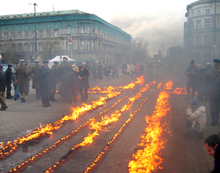
During Kwaśniewski's visit to Russia in September 2004, Russian officials announced that they were willing to transfer all the information on the Katyn massacre to the Polish authorities as soon as it became declassified. In March 2005 the Prosecutor-General’s Office of the Russian Federation concluded a decade-long investigation of the massacre. Chief Military Prosecutor Alexander Savenkov announced that the investigation was able to confirm the deaths of 1,803 out of 14,542 Polish citizens who had been sentenced to death while in three Soviet camps. He did not address the fate of about 7,000 victims who had been not in POW camps, but in prisons. Savenkov declared that the massacre was not a genocide, that Soviet officials who had been found guilty of the crime were dead and that, consequently, "there is absolutely no basis to talk about this in judicial terms". 116 out of 183 volumes of files gathered during the Russian investigation, were declared to contain state secrets and were classified.
On 22 March 2005 the Polish Sejm unanimously passed an act requesting the Russian archives to be declassified. The Sejm also requested Russia to classify the Katyn massacre as a crime of genocide. The resolution stressed that the authorities of Russia "seek to diminish the burden of this crime by refusing to acknowledge it was genocide and refuse to give access to the records of the investigation into the issue, making it difficult to determine the whole truth about the murder and its perpetrators."
In late 2007 and early 2008, several Russian newspapers, including Rossiyskaya Gazeta, Komsomolskaya Pravda and Nezavisimaya Gazeta printed stories that implicated the Nazis for the crime, spurring concern that this was done with the tacit approval of the Kremlin. As a result, the Polish Institute of National Remembrance decided to open its own investigation.
In 2008, the Polish Foreign Ministry asked the government of Russia about alleged footage of the massacre filmed by the NKVD during the killings. Polish officials believe that this footage, as well as further documents showing cooperation of Soviets with the Gestapo during the operations, are the reason for Russia's decision to classify most of the documents about the massacre.
In the following years, 81 volumes of the case were declassified and transferred to the Polish government. As of 2012, 35 out of 183 volumes of files remain classified.
Further court hearings
In June 2008, Russian courts consented to hear a case about the declassification of documents about Katyn and the judicial rehabilitation of the victims. In an interview with a Polish newspaper, Vladimir Putin called Katyn a "political crime."
On 21 April 2010 the Russian Supreme Court ordered the Moscow City Court to hear an appeal in an ongoing Katyn legal case. A civil rights group, Memorial, said the ruling could lead to a court decision to open up secret documents providing details about the killings of thousands of Polish officers. On 8 May 2010, Russia handed over to Poland 67 volumes of the "criminal case No.159," launched in the 1990s to investigate the Soviet-era mass killings of Polish officers. The copies of 67 volumes, each having about 250 pages, were packed in six boxes. With each box weighting approximately 12 kg (26.5 lbs), the total weight of all the documents stood at about 70 kg (153 lbs). Russian President Dmitry Medvedev handed one of the volumes to the acting Polish president, Bronislaw Komorowski. Medvedev and Komorowski agreed that the two states should continue their efforts in revealing the truth over the tragedy. The Russian president reiterated that Russia would continue declassifying documents on the Katyn massacre. The acting Polish president said that Russia's move might lay a good foundation for improving bilateral relations.
In 2011, the European Court of Human Rights declared admissible two complaints of relatives of the massacre victims against Russia concerning adequacy of the official investigation. In a ruling on 16 April 2012, the court found that Russia had violated the rights of victims' relatives by not providing them with sufficient information about the investigation and described the massacre as a "war crime". However, it also refused to judge the effectiveness of the Soviet-Russian investigation because the related events took place prior to Russia ratifying the Human Rights Convention in 1998.
Polish-Russian relations
Russia and Poland remained divided on the legal description of the Katyn crime. The Poles considered it a case of genocide and demanded further investigations, as well as complete disclosure of Soviet documents.
In June 1998, Yeltsin and Aleksander Kwaśniewski agreed to construct memorial complexes at Katyn and Mednoye, the two NKVD execution sites on Russian soil. However, in September of that year the Russians also raised the issue of Soviet prisoner of war deaths in the camps for Russian prisoners and internees in Poland (1919–1924). About 16,000 to 20,000 POWs died in those camps due to communicable diseases. Some Russian officials argued that it was 'a genocide comparable to Katyń'. A similar claim was raised in 1994; such attempts are seen by some, particularly in Poland, as a highly provocative Russian attempt to create an 'anti-Katyn' and 'balance the historical equation'.
On 4 February 2010 the Prime Minister of Russia, Vladimir Putin, invited his Polish counterpart, Donald Tusk, to attend a Katyn memorial service in April. The visit took place on 7 April 2010, when Tusk and Putin together commemorated the 70th anniversary of the massacre. Before the visit, the 2007 film Katyń was shown on Russian state television for the first time. The Moscow Times commented that the film's premiere in Russia was likely a result of Putin's intervention.
On 10 April 2010, an aircraft carrying Polish President Lech Kaczyński with his wife and 87 other politicians and high-ranking army officers crashed in Smolensk, killing all 96 aboard the aircraft. The passengers were to attend a ceremony marking the 70th anniversary of the Katyn massacre. The Polish nation was stunned; Prime Minister Donald Tusk, who was not on the plane, referred to the crash as "the most tragic Polish event since the war." In the aftermath, a number of conspiracy theories began to circulate. The catastrophe has also had major echoes in the international and particularly the Russian press, prompting a rebroadcast of Katyń on Russian television. The Polish President, Lech Kaczyński was to deliver a speech at the formal commemorations. The speech was to honour the victims, highlight the significance of the massacres in the context of post-war communist political history, as well as stress the need for Polish–Russian relations to focus on reconciliation. Although the speech was never delivered, it has been published with a narration in the original Polish and a translation has also been made available in English.
In November 2010, the State Duma (lower house of the Russian parliament) passed a resolution declaring that long-classified documents "showed that the Katyn crime was carried out on direct orders of Stalin and other Soviet officials". The declaration also called for the massacre to be investigated further in order to confirm the list of victims. Members of the Duma from the Communist Party denied that the Soviet Union had been to blame for the Katyn massacre and voted against the declaration. On 6 December 2010, Russian President Dmitry Medvedev promised the whole truth about the massacre, stating "Russia has recently taken a number of unprecedented steps towards clearing up the legacy of the past. We will continue in this direction."
Still, the Communist Party of the Russian Federation, as well as a number of other pro-Soviet Russian politicians and commentators continue to deny all Soviet guilt, call the released documents fakes, insist that the original Soviet version – Polish prisoners were shot by Germans in August 1941 – is the correct one, and call on the Russian government to start a new investigation, that would revise the findings of the one concluded on 2004.
Memorials
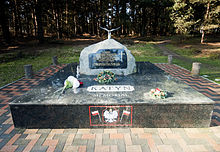
Several memorials of the massacre have been erected worldwide. During the Cold War, the British government objected to plans to build a major Katyn monument in the UK. The Soviet Union did not want the Katyn massacre to be remembered, and demanded that the British government prevent the erection of the monument. The British government did not want to antagonize the Soviets, and the construction of the monument was delayed for many years. When the local community secured the right to build the monument, no government representative was present at the ceremony (although representative of the British Conservative Party opposition were present). A monument was finally unveiled on 18 September 1976 at the Gunnersbury Cemetery amid controversy. Another memorial in the UK was erected three years later, in 1979, in Cannock Chase, Staffordshire. A memorial tablet by Ronald Sims has also been installed in the Airmen’s Chapel within Southwell Minster in Nottinghamshire. There is a large Polish community in the county and each year a service is held to remember the massacre.
In Russia, in 2000, the memorial at the Katyn war cemetery was opened. Previously, the site featured a monument dedicated to the "victims of the Hitlerites". In Canada, a large metal sculpture has been erected in the Polish community of Roncesvalles in Toronto, Ontario, to commemorate the killings. In South Africa, a memorial in Johannesburg commemorates the victims of Katyn as well as South African and Polish airmen who flew missions to drop supplies for the Warsaw Uprising.
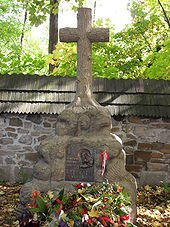
In Wrocław, Poland, a composition by Polish sculptor Tadeusz Tchórzewski is dedicated to those killed at Katyn. Unveiled in 2000, it is located in a park east of the city's centre, near the Racławice Panorama building. It shows the 'Matron of the Homeland' despairing over a dead soldier, while on a higher plinth the angel of death looms over, leaning forward on a sword.
In the USA, a golden statue, known as the National Katyn Massacre Memorial, is located in Baltimore, Maryland, on Aliceanna Street at Inner Harbour East. Polish-Americans in Detroit erected a small white-stone memorial in the form of a cross with a plaque at the St. Albertus Roman Catholic Church. A statue, the Katyń Memorial, commemorating the massacre has also been erected at Exchange Place on the Hudson River in Jersey City, New Jersey. Other memorial statues are located in Doylestown, Pennsylvania and Niles, Illinois.
In Ukraine, a memorial complex was erected to honour the over 4300 officer victims of the Katyń massacre murdered in Pyatykhatky, 14 kilometres/8.7 miles north of Kharkiv in Ukraine; the complex lies in a corner of a former resort home for NKVD officers. Children had discovered hundreds of Polish officer buttons whilst playing on the site.
In art and literature
The Katyn massacre is a major element in many works of film, literature and the fine arts. The first book in English, titled "The Katyn Wood Murders", was published by Polish émigré Józef Mackiewicz in 1951 in New York. It is central to the plot in the W.E.B. Griffin novel The Lieutenants, which is part of the Brotherhood of War series. The coverup of the massacre by the Allies is a central plot point in Robert Harris's novel Enigma and the 2001 film of the same name. Philip Kerr's 2013 novel A Man Without Breath, the ninth in his successful Bernie Gunther series, has Gunther investigating the massacre with Wehrmacht War Crimes Bureau in and around occupied Smolensk in 1943. James R. Benn's Rag and Bone (Billy Boyle series) uses the Katyn Massacre as a central plot element. Polish poet Jacek Kaczmarski has dedicated one of his sung poems to this event. In a bold political statement during the height of the Cold War, Serbian film director and screenwriter Dušan Makavejev used original Nazi footage in his 1974 film Sweet Movie. The Polish composer Andrzej Panufnik wrote an orchestral score in 1967 called "Katyn Epitaph" in memory of the massacre.
In 2000, U.S. filmmaker Steven Fischer produced a public service announcement titled Silence of Falling Leaves honoring the fallen soldiers, consisting of images of falling autumn leaves with a sound track cutting to a narration in Polish by the Warsaw-born artist Bożena Jędrzejczak. It was honored with an Emmy nomination.
The 1999 Academy Honorary Award recipient, Polish film director Andrzej Wajda, whose father, Captain Jakub Wajda, was murdered in the NKVD prison of Kharkiv, made a film depicting the event, Katyn. It focuses on the fate of some of the mothers, wives and daughters of the Polish officers killed by the Soviets. Some Katyn Forest scenes were re-enacted. The screenplay is based on Andrzej Mularczyk's book Post mortem—the Katyn story. The film was produced by Akson Studio, and released in Poland on 21 September 2007. It was nominated for an Academy Award in 2008 for the Best Foreign Language Film.
In 2008, British historian Laurence Rees produced a 6-hour BBC/ PBS television documentary series entitled World War II Behind Closed Doors: Stalin, the Nazis and the West. The Katyn massacre was a central theme of the series.

